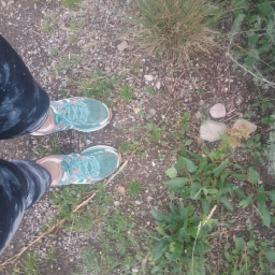To cardio first or not to cardio first

j_love10
Posts: 15 Member
Someone told me its better to do weights first and then cardio after...
Ive always done cardio first and then weights.... Have i been doin it wrong this whole time!? Why is it better to do cardio last??
Ive always done cardio first and then weights.... Have i been doin it wrong this whole time!? Why is it better to do cardio last??
0
Replies
-
Depends on goals. Glycogen levels get reduced by exercise and if you're trying to get better a lifting, then it's more efficient to lift before cardio since glycogen levels are highest at the beginning of any workout.
If you're working on your endurance and cardio fitness more than strength and muscle toning, then you can do cardio first.
A.C.E. Certified Personal and Group Fitness Trainer
IDEA Fitness member
Kickboxing Certified Instructor
Been in fitness for 30 years and have studied kinesiology and nutrition 7
7 -
From what I understand the idea behind it is to do a few minutes of a warm up, weights, and then cardio because the weights boost your metabolism and you're burning fat a lot longer with weights than with cardio (think instant, but not sustaining) weight loss. So you're already burning fat once you've lifted weights, and therefore might burn even more while you're doing your cardio.
I'm sure there are people more knowledgeable than I am that could give you a better answer than I did, but that's kinda a short summary of why people suggest weights before cardio. When I was working out all the time (working on getting back into it now) I would do a half hour of cardio before weights as a warm up, an hour of weights, and then another half hour to hour of cardio, but I loved cardio at the time.1 -
From what I understand the idea behind it is to do a few minutes of a warm up, weights, and then cardio because the weights boost your metabolism and you're burning fat a lot longer with weights than with cardio (think instant, but not sustaining) weight loss. So you're already burning fat once you've lifted weights, and therefore might burn even more while you're doing your cardio.
I'm sure there are people more knowledgeable than I am that could give you a better answer than I did, but that's kinda a short summary of why people suggest weights before cardio. When I was working out all the time (working on getting back into it now) I would do a half hour of cardio before weights as a warm up, an hour of weights, and then another half hour to hour of cardio, but I loved cardio at the time.
Thank u mam! Appreciate the advice0 -
Better yet, just do metabolic conditioning workouts (MetCon, CrossFit, Meta-Shred, etc) and do them at the same time
 0
0 -
Incorrect. This is a myth that passed on by magazines and the fitness industry in general. Any exercise burns CALORIES. Where those calories come from first will ALWAYS be glycogen. The percentage from energy sources will change dependent on the exercise, but the percentage of fat burned during exercise isn't that significant. Fat is EXCLUSIVELY used for fuel at REST, not while exercising.From what I understand the idea behind it is to do a few minutes of a warm up, weights, and then cardio because the weights boost your metabolism and you're burning fat a lot longer with weights than with cardio (think instant, but not sustaining) weight loss. So you're already burning fat once you've lifted weights, and therefore might burn even more while you're doing your cardio.
A.C.E. Certified Personal and Group Fitness Trainer
IDEA Fitness member
Kickboxing Certified Instructor
Been in fitness for 30 years and have studied kinesiology and nutrition
6 -
Depends on goals. Glycogen levels get reduced by exercise and if you're trying to get better a lifting, then it's more efficient to lift before cardio since glycogen levels are highest at the beginning of any workout.
If you're working on your endurance and cardio fitness more than strength and muscle toning, then you can do cardio first.
A.C.E. Certified Personal and Group Fitness Trainer
IDEA Fitness member
Kickboxing Certified Instructor
Been in fitness for 30 years and have studied kinesiology and nutrition
Im looking to build muscle in my legs and flatten my stomach... I have a body type to wear i only gain weight from the waist up which is very frustrating0 -
Pull petals to decide
 0
0 -
Unless you're already super fit and working toward some goal that mandates you shave off 30 seconds from your already impressive 5K speed, or you're at a low body weight and trying to gain that last pre-competition bit of muscle or lose that last bit of water weight to look stage ready, it doesn't matter at all.
Don't bog yourself down with the stuff that doesn't matter. Work out.3 -
What you have been told. Lifting first then do some cardio if you want to1
-
AmandaHugginkiss wrote: »Unless you're already super fit and working toward some goal that mandates you shave off 30 seconds from your already impressive 5K speed, or you're at a low body weight and trying to gain that last pre-competition bit of muscle or lose that last bit of water weight to look stage ready, it doesn't matter at all.
Don't bog yourself down with the stuff that doesn't matter. Work out.
This.
Yeah it's true glycogen is used as energy when you exercise. But unless you're running a long distance, say 10 miles or more before your lifts, it isn't going to matter. You will have more than enough glycogen circulating from your liver to sustain a workout.
To be honest, the only time I think it really matters is leg day lol. I always run before I lift anyways, but definitely on leg day... running with rubber legs from squats is no fun!1 -
Depends on what you're wanting to get out of it. I use lifting days to lift and that's where my effort goes...If I do cardio on those days, it's usually a walk in the AM or a zone II ride...I want to be able to put all my energies towards my lifts.
Conversely, I have specific cycling goals and follow a training program...I want/need to be able to put my efforts into cycling on cardio days. If I were to lift before a tempo ride, my tempo ride would suck *kitten*...if I were to do a tempo ride and then lift, my lifts would suck *kitten*.
I tend to focus on one or the other.1 -
Where those calories come from first will ALWAYS be glycogen. The percentage from energy sources will change dependent on the exercise, but the percentage of fat burned during exercise isn't that significant. Fat is EXCLUSIVELY used for fuel at REST, not while exercising
This doesn't even stand up to the common sense test. A well trained man has 2,000 to 2,500 kCal of glycogen when he's well recovered. Less than that is actually available for use during exercise; if you're riding a bike, you can't move the glycogen from your arm muscles to your legs.
If exercise only used glycogen, it would be impossible for anyone to exercise for more than a few hours at a time.
Because it takes days to replenish your glycogen stores, it would also be impossible to exercise again the following day.
But people routinely do this. The STP is a 202 mile bike ride. Most people take two days to finish, about 10 % do the ride in one day. RAMROD is "only" 152 miles, but involves 10,000 feet of elevation gain. People thru-hike the Pacific Crest Trail, some of them hike 45 miles per day for 2 months without a break.
In fact, when you get fit, your body adapts to use fat efficiently as a fuel source for exercise. Especially at moderate intensities.2 -
I've read that you should do cardio for a few minutes first, then lift weights, because cardio gets your blood flowing. Basically, what I have read is that more recent studies showed dynamic stretching (with cardio) is best before weight lifting and static stretching is best after weight lifting. I know different people do different things, though, and many have success with various combinations.
When I was doing strength training exercises regularly, they were endurance-focused (in some cases, as many as 50 reps). I found that after running for 20 - 30 min. (probably only needed 5 - 10 min. for the blood flow effect), and strength training for 60-90 min., I was quite worn out. I suppose that was the point, though.0 -
I do cardio first because I care about my running more than I do about my strength. I would have pretty crappy runs if my legs are already tired. It depends on your preference and focus, really. Don't overcomplicate things.0
-
Lifting is generally recommended first for a couple of reasons.
First, because those doing the recommending are often focused on lifting and cardio is treated as an accessory exercise. You do the exercise that you want to get the most out of first because you can put more into it.
Second, because those doing the recommending are often lifting heavy, and you want the best form possible while lifting close to your limits to avoid injury and to get the most benefit out of every lift. That's hard to do if you're coming into it already tired. If you don't lift close to your strength limits, then this isn't as important. The risk of injury isn't as high with lighter weights and you should be able to keep good form even if you're somewhat tired.1 -
amusedmonkey wrote: »I do cardio first because I care about my running more than I do about my strength. I would have pretty crappy runs if my legs are already tired. It depends on your preference and focus, really. Don't overcomplicate things.
This.1 -
amusedmonkey wrote: »I do cardio first because I care about my running more than I do about my strength. I would have pretty crappy runs if my legs are already tired. It depends on your preference and focus, really. Don't overcomplicate things.
Most people's form on strength training declines when they're fatigued, which can lead to injuries. So i'd lift in a separate session than cardio, or before cardio.
OP - Welcome to MFP. It's been asked many, many times, so search the forum..
1 -
Almost always cardio first, but my cardio isn't very intense, its more a warm up.
When I do weights, I want to push myself hard and intense cardio would diminish my ability to do that.
If I want a serious cardio workout, I never do it on weight training day.
0 -
I used to always do cardio first and then lift because I thought I was supposed to warm up first. But then I'd do like 10 minutes of strength training and be tired and done. I started doing it the other way around which worked better. I do pretty intense cardio though (30-60 minutes of cycling), so if what I was doing was less intense or I only did 15 minutes or so of it it probably wouldn't have made much of a difference.0
-
Thank you all for your comments! I appreciate it!
 0
0 -
Ever see anyone depleted from using all their glycogen stores? They don't move. And please read. I did say dependent on exercise, source of full percentage changes, but from fat storage (with the exception of possibly long marathon like training or competition) the calories burned aren't that significantly higher. Lol and it doesn't take days for glycogen restorage. Where'd you get that information from?NorthCascades wrote: »Where those calories come from first will ALWAYS be glycogen. The percentage from energy sources will change dependent on the exercise, but the percentage of fat burned during exercise isn't that significant. Fat is EXCLUSIVELY used for fuel at REST, not while exercising
This doesn't even stand up to the common sense test. A well trained man has 2,000 to 2,500 kCal of glycogen when he's well recovered. Less than that is actually available for use during exercise; if you're riding a bike, you can't move the glycogen from your arm muscles to your legs.
If exercise only used glycogen, it would be impossible for anyone to exercise for more than a few hours at a time.
Because it takes days to replenish your glycogen stores, it would also be impossible to exercise again the following day.
But people routinely do this. The STP is a 202 mile bike ride. Most people take two days to finish, about 10 % do the ride in one day. RAMROD is "only" 152 miles, but involves 10,000 feet of elevation gain. People thru-hike the Pacific Crest Trail, some of them hike 45 miles per day for 2 months without a break.
In fact, when you get fit, your body adapts to use fat efficiently as a fuel source for exercise. Especially at moderate intensities.
A.C.E. Certified Personal and Group Fitness Trainer
IDEA Fitness member
Kickboxing Certified Instructor
Been in fitness for 30 years and have studied kinesiology and nutrition
2 -
Regarding glycogen depletion/replenishment:
Ever see MMA fighters during weigh-ins? They got to those weights by cutting water weight, aka glycogen stores. They'll go out after weigh-ins, eat a bunch of carbs and drink plenty of water and go out and fight the next day at about 15-20 lb heavier than they weighed in. So, really - it can take less than a day to replenish most of one's glycogen.0 -
IF I do cardio (which is rarely now that I'm in a bulk) I only go for 15-20 minutes at the beginning of my work out to get it over with.0
-
Ever see anyone depleted from using all their glycogen stores? They don't move.
Yes, I've bonked myself. Continued riding until I got home, but it became much more difficult and painful and my power output fell substantially. I was able to continue exercising without glycogen, by burning only fat, because people can do that.
Also, this only happens when people exert themselves at high intensity. That's what "the fat burning zone" is all about. That's how you do long endurance exercise without bonking, by using mostly fat instead of glycogen, by staying at moderate intensity levels.0 -
Personally, I cardio later. If I cardio first, my squats suffer.0
-
I do cardio before lifting for one simple reason: I love lifting, I hate cardio. If I do cardio first, guaranteed I will find the energy to lift. If I lift first, 90% of the time I'll find excuses to NOT do cardio.
So if I want any cardio done at all, it has to come first or never.2 -
I lift first and do cardio after so I can make sure Im not too tired to have proper form while lifting and prevent injuries, then if I have the energy I will do 10-20 min of cardio after. but thats just me2
-
I do cardio before lifting for one simple reason: I love lifting, I hate cardio. If I do cardio first, guaranteed I will find the energy to lift. If I lift first, 90% of the time I'll find excuses to NOT do cardio.
So if I want any cardio done at all, it has to come first or never.
I'm like that with abs have to do them first
0 -
The "fat burning zone" is misinterpreted. While one burns more fat by percentage at moderate to low intensity, if the duration is the same versus higher intensity exercise, one still burns more fat calories overall doing high intensity.NorthCascades wrote: »Ever see anyone depleted from using all their glycogen stores? They don't move.
Yes, I've bonked myself. Continued riding until I got home, but it became much more difficult and painful and my power output fell substantially. I was able to continue exercising without glycogen, by burning only fat, because people can do that.
Also, this only happens when people exert themselves at high intensity. That's what "the fat burning zone" is all about. That's how you do long endurance exercise without bonking, by using mostly fat instead of glycogen, by staying at moderate intensity levels.
And as for bonking, there's a reason gel packs and other simple carb packs are around for long endurance people. The body doesn't give fat as easily as people would like to think. And even in trained athletes, the reliance on carbs is more important. Heck if it were just about converting fat for energy for long endurance, it would make sense to be a fatter athlete with less muscle.
And if you really bonked out, you wouldn't move. You likely were really depleted, but true depletion of all glycogen would leave you in a fetal position.
A.C.E. Certified Personal and Group Fitness Trainer
IDEA Fitness member
Kickboxing Certified Instructor
Been in fitness for 30 years and have studied kinesiology and nutrition
0 -
I do weights first at the gym then drive home and do Cardio on my personal bike0
This discussion has been closed.
Categories
- All Categories
- 1.4M Health, Wellness and Goals
- 398.1K Introduce Yourself
- 44.7K Getting Started
- 261K Health and Weight Loss
- 176.4K Food and Nutrition
- 47.7K Recipes
- 233K Fitness and Exercise
- 462 Sleep, Mindfulness and Overall Wellness
- 6.5K Goal: Maintaining Weight
- 8.7K Goal: Gaining Weight and Body Building
- 153.5K Motivation and Support
- 8.4K Challenges
- 1.4K Debate Club
- 96.5K Chit-Chat
- 2.6K Fun and Games
- 4.8K MyFitnessPal Information
- 12 News and Announcements
- 21 MyFitnessPal Academy
- 1.5K Feature Suggestions and Ideas
- 3.2K MyFitnessPal Tech Support Questions



















